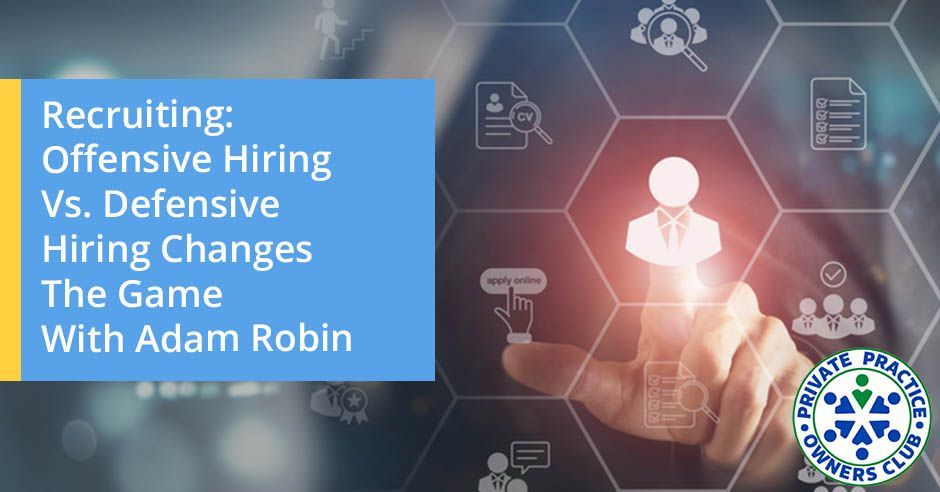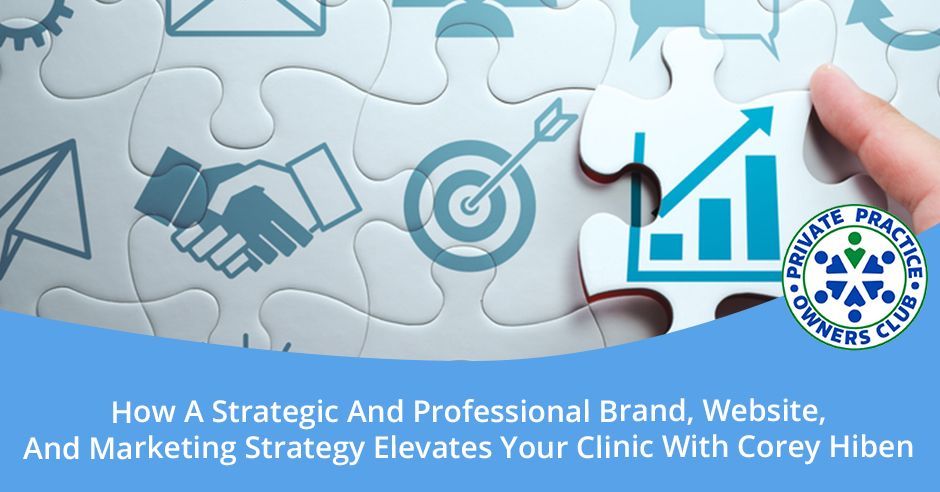In this episode, Nathan and Adam go deeper into their Private Practice Manual series, delving into the essential role of the Patient Care Coordinator. Discover why this position is indispensable and how to guarantee seamless and effective operations at your front desk.
Explore the critical responsibilities of a Patient Care Coordinator, including scheduling, billing, and ensuring high levels of patient satisfaction. Uncover the techniques for identifying and recruiting the ideal candidate who possesses not only efficiency but also exceptional sales and interpersonal skills.
Learn about the essential elements of a comprehensive job description that clearly defines the duties, obligations, and benchmarks for success for your Patient Care Coordinator. Gain valuable insights into employing efficient training strategies to ensure your PCC performs at an exceptional level, thus optimizing the overall efficiency of your clinic operations.
Want to talk about how we can help you with your Private Practice business, or have a question you want to ask? Book a call with Adam -
https://calendly.com/adamrobin/dr-adam-s-30-minute-connection
---
Listen to the podcast here
Practice Owners Manual Series, Part 6 - Patient Care Coordinator With Adam Robin
Welcome back to the next episode in our series of the quintessential bulletproof Practice Owner’s Manual for Success. Hopefully, you appreciated the previous episode, took lots of notes, and did some homework. Get ready to do some more work on your business. Get out a pad and paper. Let’s go.
---
Welcome back to the best show in the world. I am here with my partner, Adam Robin. How are you doing?
Fired up, happy, and excited. I am excited about what we’re doing. I’m excited to be here.
We are halfway through our Private Practice Manual series to create a successful private practice. Up to this point, there’s been some cool stuff that we’ve talked about and shared with people. We didn’t cover every single detail in all the minutia regarding a private practice, but what we’ve done thus far would be huge if people took the time. I talked about this either in the 1st or 2nd episode, to not try to consume and implement everything all at once.
Don’t feel like you have to implement everything from each episode. Take one thing and maybe don’t move on to the next thing until you’ve completed that one thing. We’re releasing these weekly. People might be tuning into them weekly. They might start feeling overwhelmed. I want to preface this by saying this is a journey. You don’t have to do everything so quickly, but consume it and, more importantly, implement it along the way before you move on to the next thing. Would you add anything to that?
No. I listened to you and Will Humphrey’s talk on Will’s new podcast. If you guys haven’t checked it out, check out the Will Power podcast. Shout out to Will. He said inch by inch, it’s a cinch. Yard by yard, it’s hard. I’m going to steal that. It’s like, “What’s the one win we can get in this week? What’s the one small win we can have this week?” Go back to the Time and Attention Mastery episode and implement some of those principles as you start implementing this stuff into your business. That’s why it’s there.
Not to get too tangential on this topic because we have some important stuff to talk about regarding the front desk coordinator or the PCC, the Patient Care Coordinator, what I especially found is there’s some work that I need to get done. I have a weekly meetup call with my mastermind group through PPS. We commit to doing one thing each week that we’re going to hold ourselves to and report on the next week in our weekly calls.
Because that call was coming up and I had committed to doing that certain thing, I found myself making sure it got done before the next call. If that commitment hadn’t been there from the week before, I know I would’ve blown it off. As we’re doing this, there’s a power in networking. If you have an accountability partner, a coach, you name it, that is huge for pushing these big rocks or even the small rocks up the hill to get to where you want to go. Everybody needs that kind of accountability to be held to.
Agreed.
Let’s get to it. This is part six, the patient care coordinator. Bring out your piece of paper and write at the top that part six of the Private Practice Manual series is patient care coordinator. Put that up at the top. Thinking about the patient care coordinator, and I shared this with you before we pushed record, this person is so valuable. I’ve lost lots of money through them and I’ve made lots of money through them. They are the face of the clinic. They are the first person and the last person that is seen by that patient as they’re coming in and out of the clinic. It’s vital that the experience between the patient and the person at the front desk is positive. They hold a lot of keys to your success.
They’re the face of the company. They make the phone calls, the emails, the scheduling, and collecting the money. It’s such an important relationship so much so that it’s got its little section in the manual. It’s really important. I don’t know about you, but my experience has been that the whole position was very foreign to me as a practice owner. I didn’t know anything about that stuff. I knew how to be a PT. I found myself being like, “Can you get that done for me?” All the stuff I didn’t want to do, I would give to her. I didn’t understand what her role was, how to utilize that position effectively, and how to create some synergies between that front desk and the back end of the practice too.
The initial owner of the clinic, me, back in the day was like, “I need someone to answer phones.” I assumed they knew what to say and that they were positive, and they came across well. I was assuming they had the best interest of the company in mind and that they were trying to get people on the schedule instead of taking all the excuses and saying, “We’ll cancel that.” It took a long time. It was many years, maybe over a decade, before I finally figured out, “I need to train them and tell them what to do and not assume that they know what to do.” It’s a lot more than answering the phone.
There’s a lot of money going in and out of that place too.
Your PCC Avatar
At the very top of the sheet underneath the patient care coordinator on your blank sheet, start with an avatar. Who is this person? Who is the golden child? What would you say is that avatar to you in your clinic?
I’ll preface this by saying my practice but I’ll also say that it’s probably pretty typical in most clinics. You want that person who is a social butterfly.
They have to be a people person.
They almost could be a marketer. They almost could be a good marketing person. They have a lot of relationships in the community. They’re active in the church. They may have a couple of kids. They’re in the high school. They have some influence in some of the community groups and the community clubs. They’re very social.
Ideally, my opinion is they’ve had some positive exposure to physical therapy and recognize the benefits of it.
Not only that, they have some valuable relationships with people in the community, like other business owners. That’s important. If you can picture it, it’s like they could almost be a marketer. That’s the type of person I’m looking for.
When we’re talking about an avatar, we’re talking about the ideal picture of what that person is like. Maybe they don’t check all the boxes, but if we’re going to look for ideals, let’s start from the very top and set our sights on the ideal person. As we’re making this avatar, they’ve got some grown kids, they’ve got some exposure to physical therapy, and they’re a people person.
As we’re doing those working interviews, one of those things is we’re going to ask the person that we’re interviewing who might be a potential patient care coordinator to make some phone calls. They better not be afraid of getting on the phone at any given time and talking to a stranger and be very comfortable in that space.
To the same degree, they’ve got to be very comfortable or even more comfortable asking for money. You cannot have them hemming and hawing and being like, “I’m so sorry that I have to collect this from you.” My best patient coordinators are like, “This is what you owe. This is your plan. It’s not my plan. This is what you chose or what you got at your work. We do the work, so we deserve the money.” They almost have a little bit of a bulldog-ish mentality as far as collections.
It’s bigger than just collections. It’s life. In the interview, you want that person who comes in and owns the room. They may be a little bossy but not demanding or not in an aggressive way. They’re like, “Welcome to the show.”
They’re motherly.
They’re like, “I’m going to take care of this. I got you. I don’t need direction. I’m going to take care of this. I’m in charge here.” They’re not afraid of asking for money and making sure people are getting rescheduled when they don’t want to.
They’re not afraid to say, “You can’t cancel. That’s not good for you.”
They’re like, “Not on my schedule. This is my schedule.”
They’re like, “You need to be coming in three times a week. You can’t cancel, show up once this week, and think you’re going to get better.” They need to be able to say it like that in a very motherly jovial way and talk to them like, “You need this.”
The other thing that I like to look at is somebody who can keep those spoiled brat clinicians in check too.
They’re not afraid to talk to them.
You’re like, “You’re going to see 50 this week. I’m scheduling 60 for you. You’re doing this.” They need to be Somebody who owns that front office. They’re like, “This is my schedule. This is my office. This is my domain. I’m going to take control of it.”
How do you find that kind of person?
My favorite place to buy clothes is Buckle. Have you ever been to that clothing store?
My wife loves it.
I love Buckle. When you go there, those people are like salesmen.
It’s a different experience.
If you’re going up to the sunglasses case and peeking in the sunglasses, they’re opening the case for you. They’re like, “Put these on.” They’re very sales-oriented people.
Also, they’re very nice about it.
They have a commission-based mindset. I like to recruit inside Buckle for my front desk people.
You’re kidding. You’re stealing from Buckle.
Maybe not necessarily, but if I see people, I’m like, “Do you want a new job?” That’s the type of mentality. If you haven’t been to Buckle, go to Buckle this weekend and you can find out quickly what you’re looking for. Another thing is a really good waiter or waitress. It’s somebody who’s like, “This is my table. Everybody here is going to get served at a high level. I’m going to earn my commission at this table.” Those are the two places that I see where that’s the type of person I want working the front desk.
Not for the patient care coordinator position, but there was someone who stood out at an Arby’s right next to our clinic and another person who stood out at the subway that was near our clinic. These weren’t your traditional teenager type of employees. They stood out. I know what you’re talking about.
It’s like, “I want to tip this person. I enjoy my time here.”
It’s like, “You made this a different experience.”
Here’s the thing. None of that has anything to do with CPT codes, medical office experience, or authorization. I don’t care. All that stuff can be trained or delegated to somebody overseas.
Another way that we’ve found people is by networking. I don’t think we ever hired a past patient. Maybe we did, but we were leery of hiring past patients unless they’d been discharged quite a while ago. It’s networking by talking to your team and talking to patients like, “This is the avatar that we’re looking for. Maybe you know someone that’s a great people person looking for some work that would fit in our practice.”
They’ve been to your clinic. They know the culture. They know the type of people that fit in there. You’re like, “Is there anyone out there that’s motherly or familial that wants to bring everyone together, is happy when they talk to people and can solve problems on the fly very easily and do so in a kind and loving manner? Do you know anyone like that?” Another great way of finding people is to tap into the network.
It was harder to find people through the ads that we’d place for PCC. I shared this on the show in the past. We used to do group interviews on a monthly basis, whether we were hiring or not. It was to replace the technicians that we had and the patient care coordinator positions. Those are the positions that had more churn. They were likely to give us 1 or 2 weeks' notice or not show up.
We never wanted to be in that position ever again, so we did monthly group interviews. We invited people to come. Fifteen people would say, “I’ll show up at that day and time.” Seven or eight would show up and we’d have a group interview. You can talk to me about that some other time, but that’s where we would also find PCCs.
That’s beautiful. I wrote that down. I might start doing that in my practice.
I won’t get into the details, but that was another way. I thought I’d throw that out there.
It’s important to get clear. Personality is important in that position. That first bullet point is the avatar. You’re like, “Who do we want in here?” Maybe you can write a quick story about this person, or you can bullet point some criteria that you would want to see during a working interview or some interactions. Stick to that. If you do that, then you’ve got 80% to 90% of it right. Hire the right person and you’re almost there.
Personality is important in a Patient Care Coordinator position. When you hire the right person, you're almost there.
If you’re doing that avatar exercise well, you have an idea of what age range they’re in and what kind of demographic they’re coming from. You’re even giving them a name. You’re like, “This is Bob. This is Sally.” The team says, “We’re looking for the next Sally. We’re looking for the next Bob.” When you say that, everyone knows exactly what you’re talking about.
We’re looking for this next person and all of that’s encapsulated in that avatar. What do we want to see when they come in for the working interview? What do we want to find out? What do we want to feel when we are taking them through the interview process outside of whether they align with our values? That’s understood at this point. We’ve talked enough about that. They’re going to align with the values and agree with them, but beyond that, how are we feeling? How are they acting? What kind of actions are they showing that tell us that this person would be super successful in this position?
Once you get that right, and going into bullet point number two, we’ve got to get clear on what exactly are the roles and responsibilities of that position. Not just for this position, but all positions in the company, have a very detailed job description. It is something that outlines, “Here’s the success criteria. Here are the key roles and responsibilities. Here’s how we measure how well you’re performing in this role.”
Those are KPIs.
It’s then like, “Here are some of the criteria to qualify for the position.” Documenting that is important.
The Job Description
If you take it a step further, that’s all good in the job description. I’ll reference back to my conversations with Sean Miller a few years ago on the show where we talked about building out a job description. He called it a playbook. If you have a position on a team in sports, there’s a playbook of all the plays. It’s like, “This is how we run our offense. This is how we run our defense.”
He would create a playbook for each position in the company, and the first part of that was the job description. The second part of that was, “Here’s how you answer the phone. Here’s how you collect money. Here’s how you bring in an initial valuation person,” and more of the detail gets laid into the playbook. Start with the job description first. What do you want to see? What are their key roles, responsibilities, and their KPIs? You can start building out the playbook after that.
I made the mistake in the beginning of not being clear on what the responsibility was. It’s a huge under-utilization of a big asset, one of the most important assets you have in the company. They’re not there to do authorizations. They do that, but that’s not why they’re there. They’re not there to do authorizations, run reports, verify insurance, and that stuff. What they’re there to do is to keep the schedule slammed. It’s full. There’s not a gap in the schedule. That’s their primary product. A secondary product would be collecting over-the-counter collections. One is making sure everybody’s scheduled in every time slot. Number two is collecting every single thing over the counter.
I would be interested if I could go back in time and ask my previous patient care coordinators, “What do you think your main job is? Filter it all down to one thing, what is your main responsibility?” I wonder what they would say. For those people who are tuning in, it might be a good exercise. Talk to your front desk person or patient care coordinator and say, “What is your main job? If you did nothing else, what is the one thing that you have to do to do this job?” I’d be interested to hear what they say. You and I have had enough experience that will tell you what they should say. That is to keep the schedule full, get patients to come in when they’re supposed to come in all the time and pay for their services every time they come across the clinic. That’s it.
That should probably be documented pretty clearly on the job description like, “This is what you do here.”
It’s like, “This is your job. Do this. Everything else is an accessory to it.”
Be very clear like, “This is what you do here.” Going back to the avatar, that’s why having a sales mentality is so important in that front desk because it’s a sales position. You’re selling people on their arrival. You’re selling people on the retention.
Having a sales mentality is so important in that front desk because it's a sales position. You're selling people on their arrival. You're selling people on the retention.
Also on the services. In those initial phone calls from patients who are like, “I got a referral,” or, “Do you take my insurance?” The sales mode has got to kick in right then.
That’s right. It’s like, “This is what we’re going to provide for you. This is what we need from you. This is what it’s going to cost and we need to collect that.” It’s a sales position.
I’ve had Dee Bills, the Front Office GURU, on the show at least 3, 4, or 5 times over the last number of years. We’ve talked about very specific aspects of this patient care coordinator position. I highly recommend you go back and check those out. She also will do a free consultation for you. Let her know that you came to her through Nathan and Adam of the Physical Therapy Owners Club. She’ll talk to you about what she’s able to do to help you out in this regard as well.
I’ll give a shout-out to Dee. I worked with Dee for about seven months. She helped transform that front desk and build out that role. We’ve built it out and scaled it across three clinics. It’s great. She did a good job.
Speaking of the job description, the cool thing about what you said, and relating it back to the avatar, what we get from the avatar goes back to what is most important in the job description. They play off of each other. We say all these things about what the avatar is. We know what the avatar is because we know what a successful person is who lives out that job description to a tee.
They do it because it’s fun.
They love it.
It’s not because they have to necessarily be trained on it. There is some training, but it’s their natural instinct. They get a lot of energy from communicating, holding people accountable, and taking care of people. It’s what they do naturally.
As we were talking about the avatar, these people tend to decide to go a certain direction because it’s natural to them. Occasionally, you have to turn them a little bit. You have to train them a little. They’re okay with it typically. They’re like, “I know you’re doing it this way. I wanted to tell you this is how we do it.” You’re like, “I would be happy to do it that way.” Is that what you found as well? They tend to maybe overstep their bounds a little bit and need a little correction sometimes but you’re okay with it. That’s cool. That’s awesome.
You know you have a good front desk person whenever your therapists are coming up to you saying, “They’re slamming me. That front desk is slamming my schedule. Angel up there doesn’t let up.” She’s not going to let up either. That’s when you know you have a great front desk.
You sit back and smile.
That’s right and I’m not taking the foot off the gas. Your job is not necessarily to take your foot off the gas. Your job is to figure out how to solve the problems that come from that, chaos and all those things. Solve those problems and keep the schedule full.
For those of you who are tuning in, especially if you’re newer or older PT owners, you might be thinking, and this was me, “What does a job description even look like? How do I start from scratch?” Do you have something that you’d be willing to offer to give them some guidance?
I do. We feel like throwing out bones. Here are the criteria. Number one, you have to join the Facebook group. If you’re not on Facebook, appease me and join the Facebook group. It is the Private Practice Owners Club. Join that Facebook group. Find me. My name is Adam Robin. Shoot me a DM. Let me know, “I’d love to get a copy of that PCC job description,” and I’ll send it over to you. You can take that and use it. You can copy it and paste it right into your practice or into your owner’s manual. You can maybe put your logo on the top and change up a few words. You then have a perfectly documented job description that you can use for the rest of your practice’s history.
It’s so valuable. It’s not just the PCC job description, but you can use that structure for all your other positions, the 4 or 5 positions that you have in your company. If you are starting from scratch and don’t know where to start as you’re building out a job description for any position, use this one and then build the others out. If Adam is so inclined to be so generous, he might even share some of those with you as well. There is some value in that because that’s where I was. I was like, “Where do I even start? Is this 1 A and 1 B? Am I covering everything?” This will give you that comprehensively, at least for the PCC position.
Tracking Performance Through The 6 KPIs
At the top of that job description, one of the first things you’re going to talk about is KPIs. It’s not the first thing because we’re going to talk about your purpose and responsibilities. Somewhere in there, the 3rd or 4th thing is going to be the statistics by which we measure your success. That’s the Key Performance Indicators or the KPIs that are most important to this position. Speaking of that, we talked about avatars, building out a job description, and what's most important. The third thing on your list as you’re taking notes is what are some of the KPIs and where would you start them off.
There are six primary KPIs for the front desk. I’m going to give them to you. This is section C of the patient care coordinator section of your manual. This section is called Key Performance Indicators for the front desk role or the PCC role. There are six Key Performance Indicators. Number one is a metric that all positions share in my company. It’s going to be total visits. We want to make sure that that position is very focused on, “How do I increase the volume inside this practice?” Everybody has a little role to play with that metric.
What are some of the things that they need to do to increase the total visits? Get them scheduled, make sure to get them rescheduled, get the evals to come in, and do all the things that are important to that role.
Get the evals, the schedule out, and the full plan of care at the first visit.
Get visits on the counter. Let’s get them on the counter.
Get people to come in three times a week versus one time a week plan of care and all that stuff. Don’t let them cancel. Reschedule within the same week. These are all parts of that first one to get visits up.
Even better if you’re a savvy owner, maybe they indicate what your break-even number is for the week. It’s like, “We don’t go below this number.” It’s important to let them have that internal temperature gauge week by week so that they can channel their efforts accordingly.
They know, “If we’re getting anywhere near this number, then red lights should be going off.” You want to know where they stand on the scoreboard. It’s one thing to keep pushing the number up. Whatever that number is, is that a good number? I remember that was a light bulb moment for me. I told the provider one time, “We’re going to be at 125 visits this next week,” which was super low for us. She looked at me like a deer in the headlights. This is someone who has double-digit years of experience in the PT industry.
She looked at me like, “What does that mean? She didn’t ask that but her eyes told me that. I was like, “That means we’re losing money. I’m about to have a heart attack.” It is letting your team know, “This is where we need to hit to be happy. Things are good. You can keep your jobs. I can make a profit. We can keep this place open. That’s important.” Part of this, and hopefully, I’m not jumping too far ahead, is the utilization underneath this first KPI, or is that a separate KPI?
It’s the same. I don’t necessarily think in order of importance. They’re all important. Schedule utilization, is that what you’re talking about?
Yeah. Maybe there are 200 slots for all the providers to fill during the course of a week. If they do their normal schedule, what percentage of those are filled? That’s utilization, and that’s a huge one. I know I didn’t measure it and track it. In talking to Eric Miller in the past, your greatest financial loss comes from the visits that you’re not seeing. If all your clinicians added together could see 200 visits in a week and you’re at 150 and 75% utilization, that’s not good because 25% of that is missing. You’re missing that financial capacity to be fulfilled. We want that number ideally to be mid-80s and above all the time.
Your greatest financial loss comes from the visits that you're not seeing.
That’s when you know you’re doing a good job. One that’s coupled with that would be the arrival rate. With arrival rate and schedule utilization, maybe they’re both what and what. There are some slight differences there, but the important thing is how well are we communicating the value of what we do, and how well are we holding people accountable to make sure they’re keeping their appointments. When they show up, everybody wins. The patient gets better and the clinic makes more money. Everybody wins. Our metric is 90% or above. It’s a 90% arrival rate every single week.
The industry average is much lower than that. For the successful clinics that I know out there, it’s 90% above all the time.
Going on to the next one, with over-the-counter collection percentage, we beat that metric to death in 2023. Everybody thinks they’re collecting well over the counter. They’re like, “We’re collecting everything.” Are you?
If they say no, then that’s self-implying, “I’m doing a bad job.” Everyone thinks they’re doing well because they haven’t looked under the hood. That’s why.
It’s like driving down the road without a speedometer. It’s like, “I’m going the speed limit.” Are you? Do you know that?
If I don’t look down, I’ll never know.
It’s important. You’re having this daily metric of, “What were we projected to collect over the counter?” versus, “What did we collect?” If there’s $1,000 that should be collected, you should collect $1,000, not $920. You’re not getting that $80 back ever.
This includes not just the copays for each visit but also includes collecting for projected co-insurances. If they’ve got an 80/20 plan, you collect the projected 20% at the time of the visit. That’s easy. People try to say, “Every visit is different.” It is, but on average, you collect what? Let’s say your average reimbursement per visit is $100 and they’re on an 80/20 plan. I’m going to tell my patient care coordinator, “Collect $20 at every visit no matter what.” That’s as long as their deductible has not been met and all that kind of stuff.
You’re collecting copays. You’re collecting their co-insurances. You’re collecting their deductibles for each visit. It’s not hard. If they have a $5,000 deductible that hasn’t been met and your average reimbursement rate is $100 a visit, then you collect that $100 on each visit. If it’s a little bit more for your initial evaluations, then say, “We collect $125 for initial evaluations and $100 for every subsequent visit.” Keep it simple so it’s even across the board. You don’t have to do a lot of math and calculations at the front desk. Do that every time. Start there at least to do something.
I told one of my providers, “I’d rather be cutting checks than chasing balances any day of the week.” If you focused on this one thing out of this particular episode and focused on daily reconciliations and daily accountability with a daily tracking sheet of what was supposed to be collected and what was collected, and that’s turned in every day and the credit card receipts, the checks, and the cash are all reconciled every day, if you do that one thing and make that so tight, your revenues will immediately go up 5% to 10%.
I can pretty much guarantee your revenues will go up 5% to 10% if you’re not already doing that. That’s with no additional visits. That’s no more marketing. That’s no more ad spend on social media. You name it. If you want a 5% to 10% increase in your revenues, you do that one thing and go straight to your bottom line right into your pocket.
That’s why I feel so confident about what we do and how we help people. It’s so easy to help owners find 10%, 15%, or 20% more margin in their practice by improving the operations. That’s one financial touchpoint. There are many more. It’s an important piece, especially with declining reimbursements. You have to collect over-the-counter collections. At the end of the day, what we want to do is give you, the owner, control over the outcome. You can’t have control if you’re not taking control. It’s measuring that daily. Here are the last two metrics.
I thought we only covered two.
We did total visits, schedule utilization, arrival rate, and over-the-counter collections. There are two more, and they’re both around new patients. New patients are the lifeblood of any practice. Assuming that the operations are set or assuming the operations are sound, you will grow to the degree to which you can attract and retain new patients into your practice. There are two things that are important. Number one, how many of these referrals that are sitting there on the counter are we transferring into scheduled new patients?
It’s conversion.
They come in on the fax machine as a piece of paper and convert to a scheduled initial evaluation. To do that, there’s a phone call. You have to reach out to the new patient. You have to talk to them. You have to find out what their problem is. You have to get some demographic information. You have to sell them on the idea that maybe what we do can help them. You have to get them to agree to book an appointment with us. That’s a sales process that happens on that first phone call.
Is that a separate spreadsheet that they have to track that conversion process? It’s like, “Here’s the referral.” Is that something that your team has to fill in? A lot of these things aren’t tracked on EMRs. I have been out of the EMR industry for a while because I don’t have clinics for some time. I don’t think EMRs are to the point where the potential new client and the scheduled new client are being tracked via the EMR to show that conversion rate, neither are the daily transactions of over-the-counter collections. Has your EMR gotten that far or are these separate spreadsheets that you have to build out for your PCCs?
My understanding is that they’re doing a much better job at over-the-counter collections.
The EMRs?
It’s the EMRs. The EMRs are tracking that.
They can say, “On Tuesday, these are the projected collections. This is what you got,” and they might be able to run a report.
You can get a spit-out percentage. Any good EMR should be able to either have that already in there or can custom build that for you. I haven’t found any EMR that’s doing a good job with referral management, but I do know that there are software out there that are maybe a little bit detached from your EMR that do this.
Is it like a CRM of some kind?
It’s a CRM or something like that. We have a spreadsheet. Every time a referral comes in, they have to mark it down as a referral coming in. Every time a patient gets scheduled, they have to check. Check the box. That has to be consolidated at the end of the day. It’s like, “Here’s the number. There should be five left over. Here are the five.” You do the math.
That’s a daily reconciliation as well.
It’s a daily reconciliation of all referrals. Referral conversion is a big piece. It’s 90% or above. 9 out of 10 referrals are getting booked. Let’s talk about the last KPI. Do you know what’s cool? It’s when I see an initial evaluation scheduled on my calendar. Do you know what’s even cooler? It is when they show up for their appointment. How much is the national average plan of care? How much is a plan of care worth?
Referral conversion is a big piece. 9 out of 10 referrals are getting booked.
I’d say $900 to $1,000.
If they don’t show up, you lose $1,000. At a minimum, you lost $1,000. It cost you $1,000. If you have five evals that don’t show up this week, you lose $5,000 in your practice. It’s a big lever. We measure the new patient arrival rate. They’re separate from the overall. What percentage of the new patients are arriving? These are people who don’t already know, like, and trust you. They haven’t been educated. It’s a brand-new orientation or a brand-new education process that has to take place to get that arrival, which takes energy, effort, intention, and sales. That’s unlike a traditional follow-up. It needs to be measured as such. The new patient arrival rate is the last one. You guessed at 90% or above.
That’s a pretty amazing job description right there. If you’re taking notes and that’s what you have on your list, those six KPIs, job description, and an avatar, that’d be huge. Notice in those six KPIs, we said nothing about authorizations and verifications. A number of other things, like people answering the phones or ordering materials, none of that is high on the list whatsoever. Focusing them on these things and taking those other things off their plate would be huge if you can. Allow them to focus on that. If they are able to focus on these things, then your practice will be transformed if it hasn’t already.
That person will be worth anything they ask. If they want $40 an hour, they’ll be worth it.
There are people out there who are worth it.
If they’re dialed in like that, you can have an amazing professional at the helm of that ship whose man got it dialed in.
Bend over backward for those people.
It's pretty simple. You have your Practice Owner’s Manual at the top. You’ve described your avatar. You’re going to build some recruiting, onboarding, and orientation around the type of person you’re looking for. Get clear on that. Number two, build out a job description. Join the Facebook group and DM me. I’ll give you mine.
Number three is building out a system of tracking the performance of that role via the six KPIs. Those are total visits, arrival rate, referral conversions, new patient arrival rate, over-the-counter collection, and schedule utilization. If you do that, that equals a happy owner, happy patients, and money in the bank. Everybody’s winning.
As it pertains to this particular topic, if you want to delve deeper because you’re having issues, the first thing I’d recommend you do is reach out to Dee Bills at Front Office GURU. It’s
FrontOfficeGuru.com. It’s rather simple if you punch into Google. You should be able to find it pretty quickly and get a free consultation with her.
Also, other homework you could do is there 3 or 4 episodes that I’ve done with Dee. Check those huge information value bombs. We go deeper into some of these specific KPIs that you’re talking about. the avatar, personality types, and you name it. It was quite a bit. There is plenty to digest regarding the PCC. Especially if you’re looking at a new one, thinking about adding a new one, or having questions about your current one, those could be huge for your practice.
As a teaser, for the next one, we’re going to be talking about financial mastery. There’s 1 of the 2 of us that likes talking about money. I’m looking forward to that one. That’s the next step of the Private Practice Manual series that we’re bringing to you. That’ll be part number seven. If you have any questions, reach out to me at
Nathan@PTOClub.com and
Adam@PTOClub.com. We’ll be happy to help you out and also do any consultations with you if you so wish. Is there anything else you want to share?
I would like to share that if you’re tuning in, I would love to see you win. If there’s any support you need, reach out. I’d love to help.
Thanks.
Peace out.


















